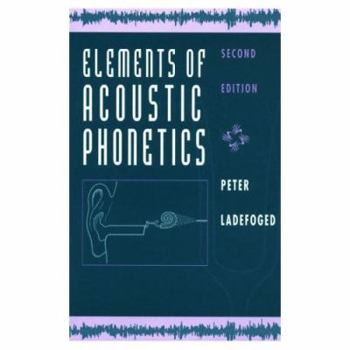Elements of Acoustic Phonetics
Select Format
Select Condition 
Book Overview
This revised and expanded edition of a classic textbook provides a concise introduction to basic concepts of acoustics and digital speech processing that are important to linguists, phoneticians, and speech scientists. The second edition includes four new chapters that cover new experimental techniques in acoustic phonetics made possible by the use of computers. Assuming no background in physics or mathematics, Ladefoged explains concepts that must be understood in using modern laboratory techniques for acoustic analysis, including resonances of the vocal tract and the relation of formants to different cavities; digital speech processing and computer storage of sound waves; and Fourier analysis and Linear Predictive Coding, the equations used most frequently in the analysis of speech sounds. Incorporating recent developments in our knowledge of the nature of speech, Ladefoged also updates the original edition's discussion of the basic properties of sound waves; variations in loudness, pitch, and quality of speech sounds; wave analysis; and the hearing and production of speech. Like its predecessor, this edition of Elements of Acoustic Phonetics will serve as an invaluable textbook and reference for students and practitioners of linguistics and speech science, and for anyone who wants to understand the physics of speech.
Format:Paperback
Language:English
ISBN:0226467643
ISBN13:9780226467641
Release Date:December 1995
Publisher:University of Chicago Press
Length:224 Pages
Weight:0.55 lbs.
Dimensions:0.5" x 5.2" x 7.9"
Customer Reviews
3 ratings
Strongly recommended
Published by Thriftbooks.com User , 16 years ago
This book is a major achievement from the pedagogical point of view. For instance, Discrete Fourier Transform basic principles are clearly explained in chapter 10 using intuitive arguments (correlation and orthogonality). The same happens with other tough subjects for those studying acoustic phonetics, like LPC (chapter 11). And some explanations come with simple algorithms, intended to illustrate what is being discussed. But, on the other side, the book has some (minor) flaws: in chapter 2, p. 18, the author gives the simple pendulum as an example of a system where frequency of oscillation is independent of the initial conditions (in this case, the initial displacement angle). This is wrong. It is approximately correct just for small angles. For angles close to 90 degrees, the error comes close to 18%; chapter 6 does one of the most common (and, therefore, one that should not be present in a book for beginners) mistakes in acoustics: taking sound power instead of sound pressure when talking about loudness; there is an excessive number of typos in chapter 11. But apart from that (which makes me give it 4 instead of 5 stars) it is an excellent start for students or professionals (my case), either from linguistics, engineering (my case) or medical sciences, in need for an introduction to this fascinating subject.
acoustics of speech
Published by Thriftbooks.com User , 17 years ago
This book is great although very basic. It is very understandable to someone who knows little about speech acoustics but a little about musical acoustics. It is easy to read and understand
Ladefoged finally found time to update his 1971 book
Published by Thriftbooks.com User , 25 years ago
Major improvements are using the source-filter in place of spring resonance model and fine tutorials on digital speech processing. An excellent first text for the student phonetician. For more advanced students use my 1999 text. J.M. Pickett.






